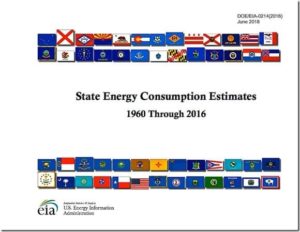by Larry Hamlin, June 6, 2019 in WUWT
The EIA AEO 2019 report shows that in year 2018 wind and solar energy resources provide about 3% of U.S. total energy consumption while fossil fuel energy resources provide about 81% of total energy use.
The dominate use of fossil fuels in meeting U.S. energy needs remains little changed from a decade ago before use of renewable energy resources became mandated and supported by lucrative government subsidizes.
Using additional EIA data the total wind and solar provided energy going back to year 2000 is available which allows an assessment of the Production Tax Credit (PTC) payments to be made.

…
by Charles the moderator , June 7, 2019 in WUWT
Fear’s a great motivator, right? So what better way to motivate people to care about climate change than to scare the crap out of them? Even if you have to leave out some details to do it?
New York Magazine climate columnist David Wallace-Wells seems to be a student at the School of We’re Hurtling Toward Global Environmental Catastrophe and We’re All Gonna Die. Last night, he shared a short piece by James Dyke, a senior lecturer in global systems at the University of Exeter, explaining some of the horrible things humanity is in for:
…

by Dr. Roy Spencer, June 7, 2019 in WUWT
Abstract: A simple time-dependent model of Earth surface temperatures over the 24 hr day/night cycle at different latitudes is presented. The model reaches energy equilibrium after 1.5 months no matter what temperature it is initialized at. It is shown that even with 1,370 W/m2 of solar flux (reduced by an assumed albedo of 0.3), temperatures at all latitudes remain very cold, even in the afternoon and in the deep tropics. Variation of the model input parameters over reasonable ranges do not change this fact. This demonstrates the importance of the atmospheric “greenhouse” effect, which increases surface temperatures well above what can be achieved with only solar heating and surface infrared loss to outer space.
…
by Prof. Samuele Furfari, June 7, 2019 in ScienceClimatEnergie
In its Special Report n° 15 “Global warming of 1.5°C” (SR15) [1], IPCC proposes four scenarios to limit Earth temperature increase to 1.5°C. In all scenarios CO2 emissions are kept at virtually zero by 2050. These scenarios are based on the technology called Carbon Dioxide Removal (CDR) that will remove CO2 to compensate CO2 anthropic emissions.
“All pathways that limit global warming to 1.5°C with limited or no overshoot project the use of carbon dioxide removal (CDR) on the order of 100–1000 Gt CO2 over the 21st century. CDR would be used to compensate for residual emissions and, in most cases, achieve net negative emissions to return global warming to 1.5°C following a peak (high confidence). CDR deployment of several hundreds of Gt CO2 is subject to multiple feasibility and sustainability constraints (high confidence). Significant near-term emissions reductions and measures to lower energy and land demand can limit CDR deployment to a few hundred Gt CO2 without reliance on bioenergy with carbon capture and storage (BECCS) (high confidence)” (page 19).
IPCC defines “Carbon dioxide removal (CDR)” as follows : Anthropogenic activities removing CO2 from the atmosphere and durably storing it in geological, terrestrial, or ocean reservoirs, or in products. It includes existing and potential anthropogenic enhancement of biological or geochemical sinks and direct air capture and storage but excludes natural CO2 uptake not directly caused by human activities” (page 26).
The fourth scenario recognizes the logical and inevitable increase of CO2 emissions if the world continues its growth to remove poverty and allow Asia and Africa countries to develop. Therefore, this scenario is based on a massive use of the CDR techniques as the report says: “Emissions reductions are mainly achieved through technological means, making strong use of CDR“.
Indeed, CDR is just rebranding of the CCS concept that is a cul-de-sac technology for a lack of economy, a lack of available adapted geological sinks on the production sites and also a lack of population acceptance.
…
La géologie, une science plus que passionnante … et diverse


